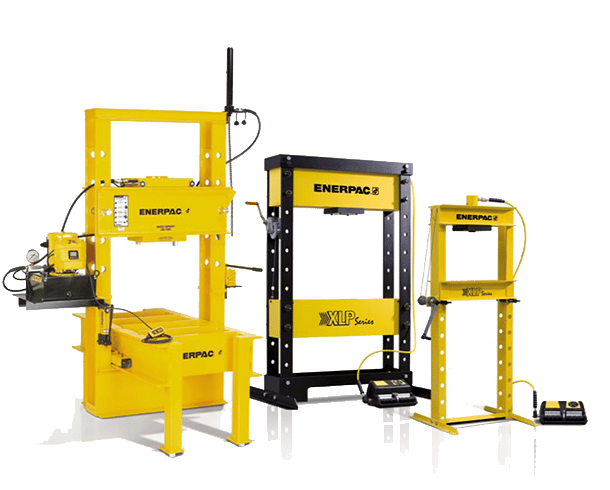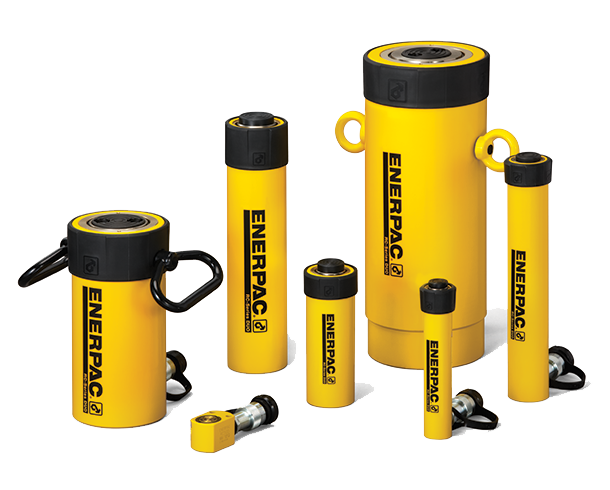Different Types of Hydraulic Presses Explained
As a manufacturer, you probably need hydraulic presses. At Worlifts, we offer exclusive access to some of the world's greatest brands, such as Enerpac presses and pumps. However, there are many different types of press. So here's an explanation of the liquid presses your business needs:
- What is a Hydraulic Press?
- How Does a Hydraulic Press Work?
- Hydraulic Press Advantages and Disadvantages
- What Types of Hydraulic Press are There?
There are numerous types of hydraulic press, but they operate on the principle of Pascal’s law of pressure. Many are also similar in design and operation, while others are made to be portable and more versatile than others. However, with our guide, finding the right one is easy.
What is a Hydraulic Press?
Using the pressure of a liquid in relation to Pascal's law, a hydraulic press gives you the ability to apply pressure to many materials easily. Commonly used in construction, hydraulic presses can also be used for almost anything because of their power. Materials such as rubber, wood, metals, and plastics can be shaped and formed with a frame presses. There are many manufacturers of hydraulic press machines. And some manufacturers are recommended over others based on quality. Some of the best include Enerpac, Savage and Beckwood.
You can order hydraulic presses from reputable resellers or direct from manufacturers. There are also many types of liquid-powered press, and the one you need depends on your project. However, you will likely use your hydraulic press for setting, separating, flattening, compression or repair work. While you might be used to working with mechanical presses, hydraulic presses offer some distinct advantages. Advantages such as greater flexibility, more forming options and reduced expenses.
How Does a Hydraulic Press Work?
The concept behind a hydraulic press can sound complex. Yet how a liquid press works is relatively simple. The main component of a press works with two parts; a plunger and a ram which are two cylinders connected to each other. The plunger is smaller than the ram, which is essential to applying Pascal's law to the device. Pascal's law dictates that any pressure exerted onto one part of a liquid body is the same throughout; Pressure = Force/Area[1]. Pressure is applied to the plunger, which presses out the fluid contained between the cylinders.
Modern frame presses use pistons which are driven pneumatically to press the liquid between the cylinders continuously. When the fluid between the cylinders is pressed, a large amount of pressure is created. Some press machines use an accumulator, which stores the pressure, so you don't have to run your press continuously. In a standard H-frame press, the pressure created by pressing the liquid with a plunger drives the ram downwards to deform a material, known as a slug. There are many types of press, each with its pros and cons according to use.

Hydraulic Press Advantages and Disadvantages
There are many uses for a hydraulic press machine. Depending on your project, different presses are more suited to the situation. A press is excellent when significant compressive force is required. For instance, a typical hydraulic press for construction will deliver between 1,000 and 3,000 psi[2], depending on the type of press and the manufacturer.
The Advantages of Using a Hydraulic Press
Aside from the frames, most presses are of the same core design, using pistons and cylinders. So if you are familiar with one, you can use any other. They're also portable for easy setup and transportation. Presses from brands like Enerpac last for years when adequately maintained.
The Disadvantages of Using a Hydraulic Press
Hydraulic presses are excellent machines with numerous capabilities. However, many presses are limited to pressure output which you cannot exceed. Additionally, certain hydraulic liquids and the oil in the machines are flammable[3] and pose a fire risk when not well-maintained.
Whatever your sector or project, you can make use of a hydraulic press. Presses are excellent for maintaining force or applying rapid forces to many materials. Their simple design means anyone can learn to use them, and they're all relatively the same. Yet the pressure of liquid presses is limited, and some of the liquids used in their operation can ignite or explode.
What Types of Hydraulic Press are There?
There are numerous types of hydraulic presses to apply pressure over a long period or rapidly. For example, you might want to combine materials into a composite form. Therefore, you would apply pressure for an extended period for compositing materials. Or you can apply great compressive force quickly and in succession for medicinal tablet manufacture.
So your sector and desired use for pressure determine the type of press you need. And there are many different designs available such as the standard H-frame or stronger bench frames, made of a frame and a bolster. The frame supports and steadies the machine. And the bolster supports the materials you are working with and allows you to line them up with the press.
H-frame Press/Work Press
H-frames are so-called because they provide a table with supporting legs for the bolster and press. In addition, they are usually larger with a movable bolster. Therefore they are often used for repair and maintenance or low-volume manufacturing using pressurized or electric pumps.
The pros of using an H-frame press
- A standard design that is easy to work with and requires little maintenance.
- Works well with common manufacturing devices such as pressurized air.
- Typically more cost-effective than other designs because of their simplicity.
The cons of using an H-frame press
- Smaller and less powerful design so not suited to large-scale production.
- You cannot move the bolster, so it is only helpful for smaller projects.
- The pressure is usually lower than in other designs and cannot exceed the maximum.
H-frames are an excellent entry-level device capable of handling smaller jobs such as repair work or small-scale production. However, while simple to operate, they are typically limited to a stationary bolster. As a result, they don't offer the high pressure needed for larger projects.
Roll Frame Press
While similar in size to an H-frame press, a roll frame press offers superior versatility. Although the bolster is fixed in position, you can move the head that supports the press along the length of the much longer bolster. Therefore, you can work on much larger pieces of material.
The pros of using a roll frame press
- Much longer bolster than the standard H-frame hydraulic press machine.
- Allows you to freely move the press rather than the materials for better alignment.
- It offers safety when working with heavy materials via lifting mechanisms.
The cons of using a roll frame press
- Heavier than standard devices, and the bolster is fixed in place.
- More expensive to purchase and maintain because of the mechanical parts.
- Requires some training to operate safely.
A roll-frame press is similar to an H-frame. However, they are much larger and can support heavier loads because of a fixed bolster. Therefore, you move the head rather than the materials when working. But this requires training to operate safely, or you risk injury.
Bench Frame Press
Bench-frame presses are essentially portable H-frame presses. They are compact in design and can typically be placed on workbenches or tabletops. Therefore, they are excellent for rapid low-volume facilities where space is limited, such as quick repair work.
The pros of using a bench frame press
- Excellent portability, compact design and can be used with a hand pump.
- Almost the same as an H-frame and, therefore, easy to use.
- Great for low-volume yet speedy jobs like metal bending or bearing production.
The cons of using a bench frame press
- The smaller hydraulic press machine design means the pressure is intense but limited.
- No movable head or bolster, so you need to align materials perfectly.
- Using specific materials in the smaller allowable work area can be tricky.
When space is limited, and you need to perform smaller tasks, these types of hydraulic presses are excellent since you can easily move them. However, they aren't as strong as larger devices. As a result, you have a limited work area and a stationary bolster for manual alignment.
Arbor press/C-Clamp Press
Arbor presses and C-frame clamps are similar but not the same. Both are portable, yet you can detach cylinders and mount arbor presses onto almost any surface. Yet they can handle higher pressure than C-clamps. C-clamps are better for holding materials in place[4] on a surface.
The pros of using an arbor or c/clamp press
- Portable and lightweight design with impressive compressive force up to 30 tonnes[5].
- Hand operated so requires no extra equipment such as an electric pump.
- Can align and compress materials vertically or horizontally for greater flexibility.
The cons of using an arbor or c/clamp press
- Not as much pressure as larger frame presses due to manual operation.
- Open operation means there are no built-in safety features when using these clamps.
- Minimal working space is only suitable for smaller jobs such as pressing jewels.
Arbor presses and C-clamps are excellent for pressing materials together. Their compact and portable design also means you can use them on almost any surface. However, manual operation means the pressure is limited, and there's a higher risk of injury when using them.
Enerpac Hydraulic Presses
These are the main types of hydraulic presses most commonly used. Across many sectors, from home-made jewellery businesses to high-volume auto-parts manufacturers, you will see one or more of these types in use at sites worldwide. Reputable brands like Enerpac offer highly versatile and safe designs built to last with proper maintenance. While just one of these press types will be a great help, you will typically require multiple configurations depending on your materials and production goals.
related Expert Guides
Ready To Buy?
Check out the hydraulic cylinder range directly available from our shop.
If you are unable to find the ideal solution or require assistance then Worlifts team of in-house experts are able to assist. Send us a message via our contact form or call us on +44(0)121 460 1113

Need To Hire?
Check out the hydraulic cylinder range directly available from our hire range.
If you are looking to hire then Worlifts offers an extensive range of Hydraulic Tools. Contact our in-house experts who will be happy to assist. Send us a message or call us on +44(0)121 460 1113